While I’ve been quite impressed by the new trolley buses in Wellington,
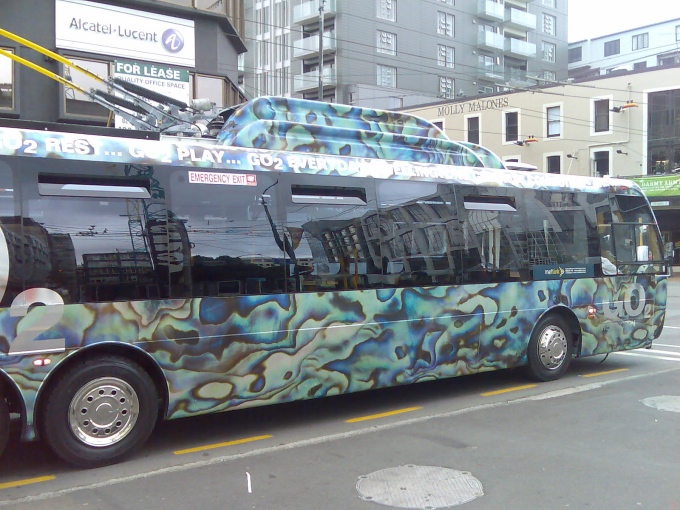
one gleaming in its paua-shell colour-scheme as it slides silently through the city, I still have a hankering for a double-decker, which are fairly common throughout England, and of which we seem to have one roaming solo in the streets of Wellington. It is of course a RouteMaster, the most famous of all the London Transport double-deckers, and well-deserved of its iconic status (iconic: that word again, but yes, on this occasion truly deserving).
Other double-deckers came before and after: none were as well-designed or as well-liked as the Route-Master, due to its speed, lightness, quietness, safety and comfort. They’re factors any modern bus designer could take note of: the speed was at getting passengers on and off the bus (double-width permanently-open rear entry, instead of squeezing past the driver at the front), but lacking in the savage acceleration of modern buses that end with you tumbling down the aisle; safety because there was a conductor on board, not just a cctv camera; lightness because the aluminium body and integrated chassis weighed a third less than later buses; quietness because the windows could not, would not rattle, opening on a careful ratchet, and not sliding in a loose metal track.
Personally I liked them because you could run after them and jump on the rear as they puttered down the road: unfortunately, because of idiots like me and the fears of the nanny state in Britain that people would fall from the rear, the last Mayor of London, Ken Livingstone, banned them last year, and bought in the much-hated long thin “bendy-buses” that just clogged the streets of London and worsened already miserable traffic-jams by jack-knifing across the narrow London streets. Despite Ken seemingly being in a job for life, he was voted out last year and replaced by “Bonkers” Boris Johnson, arguably on the issue of buses alone: Boris campaigned on getting rid of the bendy-buses and bringing back the RouteMaster – and he got in. A Mayor who rides a bicycle and brings back buses: now there’s a thing for Wellington to consider.
Of course it is easier to say than to do, to bring back a bus that you’ve sold to another company: the RouteMasters aren’t coming back. Bang goes the ironic vision – sorry, iconic vision.
But hold on a minute, what’s this? It seems that a competition was held to design a NEW RouteMaster – or at least a modern version. I’m unsure if it was officially sanctioned or whether it will really go ahead: but the competition results have been announced, and for once I’m rather impressed by the result.
It seems that Aston Martin have teamed up with Foster and Partners, and come up with an answer for the city: a new icon. Aston Martin of course are specialists at hand-made vehicles with a luxurious retro-timbered interior, clad in a modern sinuous body of aluminium and steel, if not exactly known for their bargain-basement pricing. They’re also known for producing cars with a blistering speed, although who knows who or what chance the company has of survival, as the market for luxury cars has clearly hit the skids. What better company therefore to design a new sexy bus for Britain?
Norman Foster and his team of 600 shaven-headed young acolytes are normally better known for designing buildings than buses, but they have done it before: apparently back in the 90s the company designed a solar-powered electric bus for ferrying passengers around Kew gardens. I’ll leave you to look at the pictures in peace, and in the meantime ponder this: just imagine a vehicle like this, as a trolley-bus or light-rail vehicle snaking its way through Wellington.


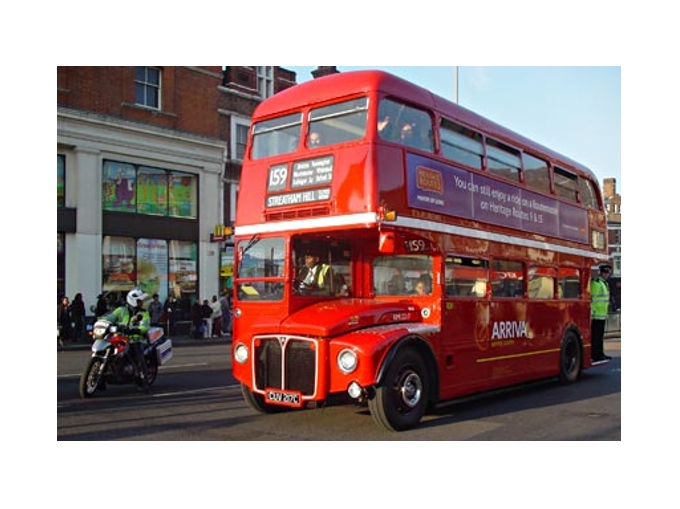
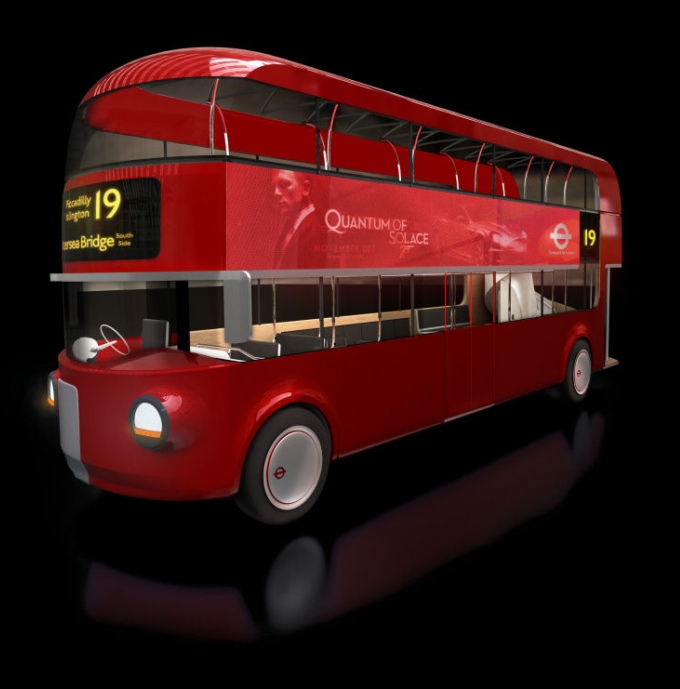
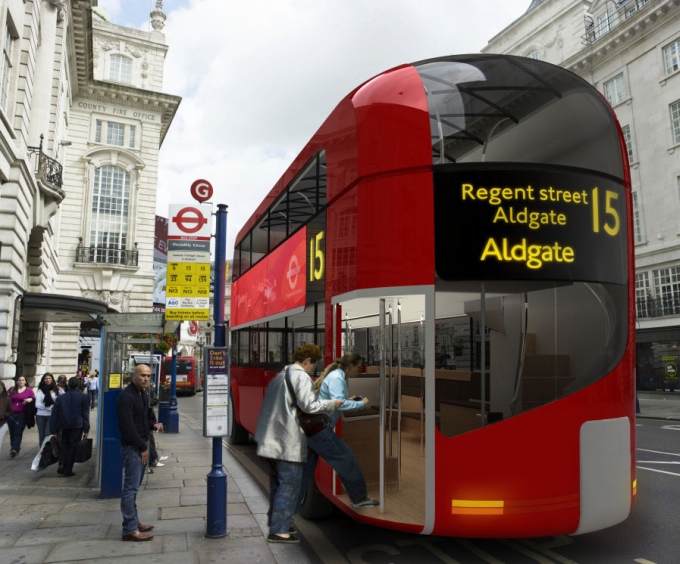
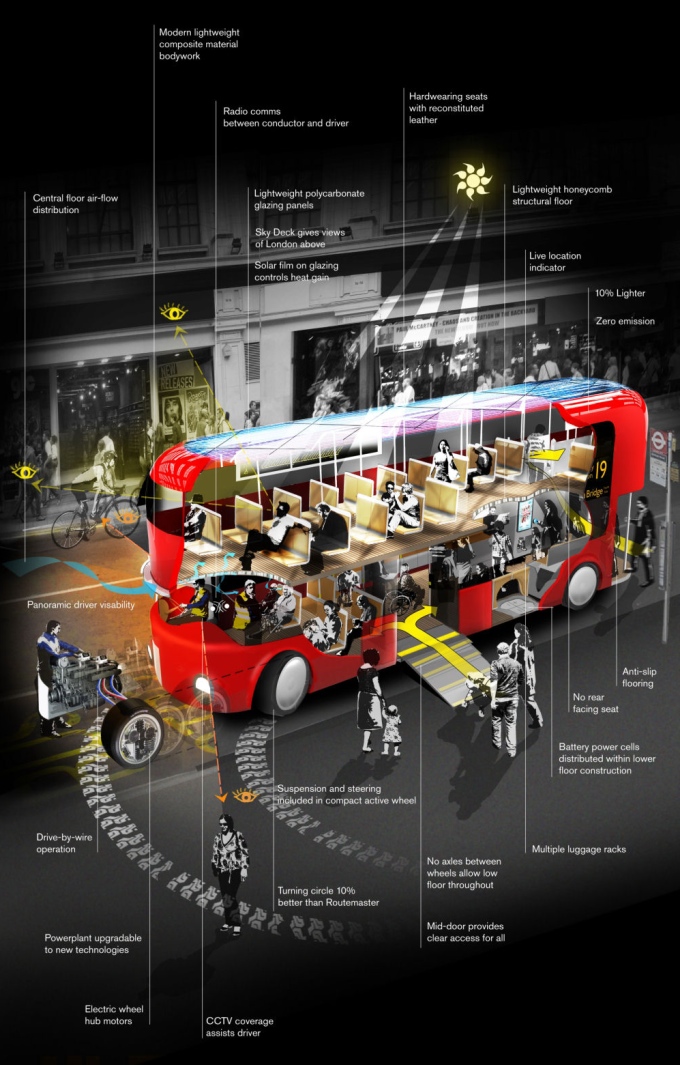
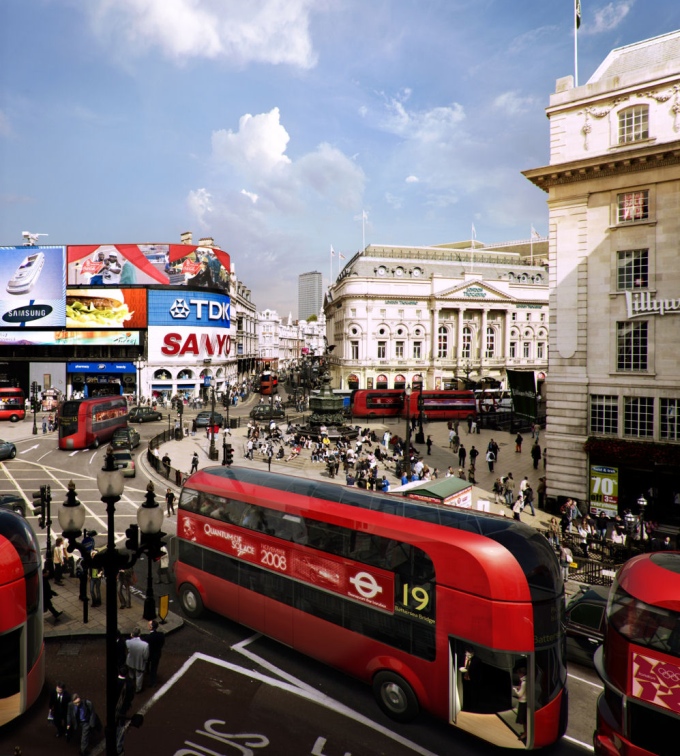



Hmmm: little in-joke from Fosters there: the number 19 bus goes direct to Fosters office, south side of Battersea bridge.
I like the buses though: very slick. And fantastic for architects with the glass roof.
a fairly popular move I would have thought. Check out these responses from the This Is London magazine published online. Definitely a major reason for Johnson to get in….
YES! YES! YES! Get rid of those frightful “bendy” buses – the Routemaster was always a delight to travel on when I made the occasional trip to see friends and family, and whoever thought it a good idea to rid London of these design icons needs to be padlocked in a straight-jacket with the key thrown away.
Honestly, I know it sounds nostalgic, but how much more of our history, identity and heritage is going to disappear thanks to the wishy-washy cloth-eared muppets we have running – sorry, RUINING this once great country of ours.
Good on you, Boris. You get my vote on this (and I don’t even live in London!)
– Adam Simmons, Lincs.
i think boris johnson should bring back the routemaster bus back to the streets of london as they are an iconic land mark and are very much loved by all bring back our buses .
– Douglas Rodway, edmonton
I agree, I was a conductor on the route 22 and 14 out of Putney garage and I think it was a bad idea to scrap one of London’s pride and joys.
– Darren Angus, london
Yes, it was officially sanctioned – and there were 2 winning designs (the other was a less cool version by Capoco Design). In theory one of these will be built and on the streets by 2011.
http://www.tfl.gov.uk/anewbusforlondon/
Love the paua shell colour of the Wellington buses though – very unique.
The bendy buses are very efficient for moving passengers when they are configured with three sets of doors, the front and back sets being for passengers boarding and the middle set for passengers alighting.
Imagine buses configured like that in Wellington – I know there are downsides, but the huge bottleneck of buses on Willis Street at rush hour would move along so much quicker.
I’ve replaced the bodged photo of the pauabus with one I took that shows the flanks much better. According to Poneke’s blog, there is only the one paua inspired bus.
Pity there’s not more.
I actually e-mailed Go Wellington a few months back about the possibility of using bigger buses, and here was the response (my original message is below):
“Thank you for your email regarding different types of bus to help carry
more passengers with the increase of passengers.
Presently NZ Bus is doing a review of the types of buses it requires to
purchase in the future, part of this review is the investigation of
Double Decker and Articulated buses and whether these types would be fit
for purpose. The Auckland operation does operate a number of
articulated buses presently and these are due for replacement in the
near future.
The review is also looking at replacement of the mini bus fleet that is
operated out in the Hutt Valley and to understand where these will fit
better in the operation going forward.
In regards to operating Double Decker and articulated buses in
Wellington we do need to be aware of constraints that we operate under
this includes the over head wires for the trolley bus fleet and could
mean double Decker buses cannot be used or the narrow roads within the
Wellington region, this is due to the rear of the articulated buses
swing wider than a normal type bus and therefore will mean we need to be
aware of parked cars or traffic in other lanes which may be damages with
the tail swing of this type of vehicles.
Thank you again for contacting me and I hope the above helps.
Thanks and regards
XXXXXXX
Paula
—–Original Message—–
Submitted on 12/06/2008 – 23:16
Submitted by anonymous user:
Submitted values are:
Subject: Alternative bus types
Comments:
With the rise and rise of petrol prices, public transport is struggling
to meet demand.
I have briefly researched two possible solutions that could
simultaneously address the issues of passenger capacity and driver
recruitment – double decker buses
(http://en.wikipedia.org/wiki/Double-decker_bus) and articulated buses
(http://en.wikipedia.org/wiki/Articulated_bus).
I am aware that double decker buses may not be able to clear the
overhead wires in their current structure, and Vector Energy is probably
too cheap to raise them higher off the ground.
Articulated buses have been known to have issues with uphill climbs in
the diesel variety, and can be more costly to maintain than conventional
buses.
In the case of both, would they need specialised training to drive them?
Nonetheless I do think the above examples are worth considering in order
to boost public transport capacity.”
thanks Deep. It seems a slightly confused message to me – where the spokesperson says:
“….and could mean double Decker buses cannot be used or the narrow roads within the Wellington region, this is due to the rear of the articulated buses swing wider than a normal type bus….”
The comment seems to be melding both different types of buses together. I’d agree about the bendy buses – they really are beasts to try and get around, past, and (not under).
But the fact that there is one double decker happily tootling around at present means that the lines must be set high enough, presumably everywhere (i’m assuming that they haven’t just got higher level lines down Lambton Quay, where the English Rose parks on Saturdays….). The view from the top of a double decker is fantastic – very good way to see the city!
I’d say for a ‘proper’ double decker for practical use, rather than tourism, the trolley wires would have to be raised an extra 50-100cm from the ground. And that’d up to Vector Wellington’s new Hong Kong owners, if they’ll even give a toss.
actually, you’ve got a good point that i hadn’t considered – while a single storey trolleybus can fit under the wires, and a double decker bus can fit under the wires, there’s probably no way a double decker trolleybus could also fit under, and still take power off the lines.
But then they could always figure out a slightly different system, like a pantograph system.
As I understand the wires are in fact high enough for double deck trolleys to operate. Talking to someone as Stagecoach, the previous owner of the trolley buses, they had applied to test a Hong Kong double deck trolley in Wellington but were declined as the bus was too heavy/long for NZ regulations.
The main issue for double decker buses in NZ is simply a matter of permitted axle weights. NZ has low axle weights by international standards and as a result when double decker buses are operated here they are limited in how many passenger they can carry without exceeding permitted axle weights. This defeats the purpose of having a bigger capacity double deck bus.
Also Hataitai bus tunnel is an issue for double deckers.
Bendy buses have been tested some years ago in Wellington and a test bus from Auckland apparently did get stuck up in Khandallah. But most main routes technically can be operated by bendy buses. Modern articulated buses have the same swept path as a rigid bus so tail swing shouldn’t be an issue if new artics were being introduced.
Problem for articulated buses is they would require lengthening of bus stops and possible modifications to bus termini to allow longer buses to turn. This would require the City Council to time consuming and thankless work extending bus stops which inevitably would mean removing on street car parks, while the financial benefit of any efficiency gains from bigger buses would fall to the bus operator and the Regional Council.
I love the double-decker London buses, they were my main form of transport for living and working in that fantastic city. (- despite bus strikes.)
Aside from the classic double decker design, if there was just one thing Wellington Buses need to learn from Transport for London (TFL) is how their ‘Oyster’ Card system works compared to our current ‘Snapper’ System.
On the surface there’s not much difference between the two – obviously the marine- life theme was popular. But there’s some fundimental benefits with Oyster, that Snapper could take onboard.
The Oyster like the Snapper, you pay an intial deposit. – but, then thats it. There is no further charges when you put money on the card. I resent the fact that Snapper makes me pay a charge for putting money on it. Somewhat ironic, when the concept of using snapper is to ‘save’ on fares. I honestly don’t know anyone who uses it for anything other than fares – we all have credit and eft-pos cards for that, so someone didn’t do their marketing reseach to well.
Swiping in with Oyster I was charged full fare, regardless if I was getting off at the next stop or travelling from one end of North London to the other. Fares were set at the one price – rather than the diferent fares for different zones. The benefit to the one fare system is you don’t spend ages waiting to swipe off, and don’t get charged a premium if you forget.
And lastly (if your’re still reading,thanks for bearing with me during this rant,)the Oyster swiping stations are far superior. After each use, the screen showed how much was left on the card – and it didn’t have to constantly verbally remind me to swipe-out.(The effect of on bus drivers sanity, is a worthy psyhcology paper.) Invaluable if you’re a dis-organised person like me who doesn’t want to waste time checking websites.
Quite frankly Oyster was a better, more refined system. Wellington buses could learn a lot from the hard lessons TFL had to make.
God please no articulated buses. The new Wellington buses are already too big, too fast and (the diesels) too loud. What’s the benefit in getting people out of cars and into public transport when the streets are increasingly dominated by these intimidating juggernauts? Twice I have come within a whisker of being hit by one while walking on the footpath, as the driver makes a turn with the wheel in the gutter and the leading corner of the bus sweeping over the kerb.
As for the thought of being on a bicycle alongside a bendy bus – christ, the existing ones pull in and out on me enough already. Give them a longer machine and they’ll wipe me out without even noticing the bump.